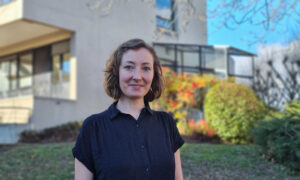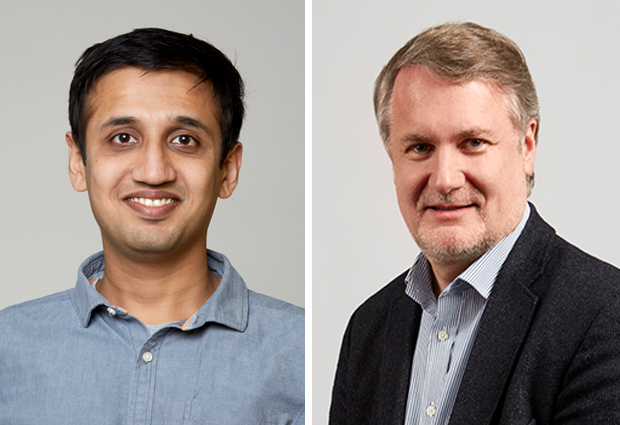
Read the latest Issue
Scientists honoured for contributions in cancer immunotherapy and structural biology

EMBL alumni are driving scientific investigation and discovery across a broad spectrum of research areas, and this is reflected and celebrated in the annual alumni awards. Patrick Baeuerle receives the 2019 Lennart Philipson Award for his pivotal role in the development of immunotherapy drugs to treat cancer, and the John Kendrew Award goes to Tanmay Bharat for novel applications of cryo-electron tomography in visualising the molecular structures of bacterial communities.
In the course of a research career spanning several decades, Patrick Baeuerle, currently Executive Partner of healthcare investment firm MPM Capital, has spearheaded the development of a novel class of biological drugs for treating cancer. This kind of drug offers hope in cases where conventional treatments have poor outcomes. “There has been a real revolution in cancer therapy. In addition to chemotherapy, radiation and small molecule targeted inhibitors, clinicians now have a fourth addition to their arsenal, and this is immunotherapy,” says Baeuerle.
There has been a real revolution in cancer therapy.
Immunotherapeutic drugs activate a patient’s immune system to recognise and eliminate cancer cells. Under Baeuerle’s leadership, scientists at the biotechnology companies Amgen and Micromet developed antibodies known as ‘bispecific T cell engagers’ (BiTEs), which essentially form a bridge between immune cells called T cells (which have an innate ability to target tumours) and cancer cells. Bringing the two types of cell into close contact using a BiTE antibody greatly facilitates the destruction of cancer cells.
As Baeuerle explains, the BiTE antibodies are very simple in concept. “They bind with one arm to cancer cells and the other arm grabs on to T cells. Just by making that connection, a T cell is able to kill the cancer cell that is temporarily associated with it. The T cell can then do the same thing over and over again, killing multiple cancer cells. This explains the enormous potency of this class of immunotherapy. Just micrograms per day yield very robust responses in patients.”
One of these BiTE antibodies, called blinatumomab, was approved in record time – less than three months – by the US Food and Drug Administration for adults suffering from relapsed or hard-to-treat cases of acute lymphocytic leukaemia. It has also shown positive outcomes in patients with non-Hodgkin lymphoma. Amgen currently has more than a dozen drugs of this kind in clinical development, targeting various types of cancers. Although there have been indicators of success in the treatment of ‘liquid’ tumours (like leukaemias and lymphomas), the treatment of solid tumours using immunotherapies remains a challenge. As Baeuerle says, “The holy grail is to go after solid tumours.” The effectiveness of the many T cell-engaging antibodies currently in development remains to be determined, but the active research in this area is indicative of a shift towards a new paradigm for treating cancer.
Reflecting on his time at EMBL, where he conducted part of his PhD research, Baeuerle comments on the valuable connections he made with other scientists. As he says, “An advantage of EMBL is that essentially all luminaries pass through there at one time or another.” It was at EMBL that Baeuerle first met Nobel Laureate David Baltimore, under whose mentorship he subsequently conducted postdoctoral research at the Massachusetts Institute of Technology.
An advantage of EMBL is that essentially all luminaries pass through there at one time or another.
When asked what advice he would give to young researchers starting out at EMBL today, Baeuerle says the key thing is to create multiple options for each career step, and to be very well prepared. “I meet a lot of young people whom I try to advise, and what I realise is they all believe they can plan a scientific career very much like travelling around the world, with precise steps and connections all the way through. But you cannot plan to become a professor, an EMBL Director, or a Nobel Prize winner. Likewise, you cannot plan what you will discover, and therefore you don’t know what you will publish. Your first-author publications are essentially the tickets to the next level. My advice then is to always focus on the very next step, not on two or three or four down the road. You have to perform extremely well at each step, and then take the next one.” He adds, “Looking back, I would never have thought I’d develop a cancer therapy, join a venture capital firm, start six new biotech companies, or win the Lennart Philipson Award! It’s about grabbing all the opportunities that are in front of you and making the best out of where you are right now.”
Rather than living as single cells in monocultures, most bacteria on Earth exist in multicellular communities called biofilms. Taking on the challenge of understanding these biofilms using structural biology is Tanmay Bharat, currently a group leader at the Sir William Dunn School of Pathology at the University of Oxford, UK. Bharat is at the forefront of research applying advanced cryo-electron microscopy (cryo-EM) imaging to uncover the molecular mechanisms by which bacteria go from single cells to a community style of living. “It’s an underexplored area of fundamental biology, because of the technical difficulties in studying cells that are part of a biofilm community,” says Bharat. “In terms of practical applications, the structures that we resolve could potentially be used as targets for antimicrobial drugs.” To this end, he has been developing novel cryo-electron tomography (cryo-ET) techniques for high-resolution structural refinement of molecular structures, ever since he joined EMBL in 2008.
It’s an underexplored area of fundamental biology.
Bharat carried out his PhD research at EMBL in the laboratory of John Briggs, before going on to conduct postdoctoral research in Jan Löwe’s group at the Medical Research Council Laboratory of Molecular Biology (LMB), in Cambridge, UK. While at EMBL, Bharat described for the first time the structure of the lattice of proteins that mediate the assembly of immature retroviruses; an essential first step in understanding how such viruses mature to become infectious. He also generated insights into the structure and assembly of filovirus pathogens such as Marburg and Ebola viruses. “When I joined EMBL, before the cryo-EM ‘revolution’, other techniques such as X-ray crystallography were much more fashionable,” he explains. “As the birthplace of cryo-EM, EMBL has always been a supportive environment for cryo-EM research, so with the advancements in microscope and detector technologies, we were able to apply our image processing tools to solve long-standing problems in pathogenic virus assembly.”
Another important recent outcome of Bharat’s research was the development of image analysis tools for tomography at the LMB, in collaboration with Sjors Scheres and Jan Löwe. For example, using these and previous methods, the first atomic-resolution structure of a surface layer lattice on bacterial cells was resolved. The imaging and image analysis tools that Bharat has been developing will be used to resolve structures of important antibiotic target molecules directly in situ in bacterial cells.
Bharat’s interest in infection and his motivation to embark on a career in this field of research can be traced back to his childhood, when he suffered from osteomyelitis, a rare infection of the bone. “I wanted to study human infections, to make a positive contribution to the field,” he says. “That’s what drove me to conduct research on pathogens such as bacteria and viruses.” Although he suffered from a recurrence of the bacterial bone infection after moving to Oxford to take up his current research position, this time he was uniquely placed to use the experience constructively to inform his research. “We’ve teamed up with my surgical team at the Oxford University Hospitals, and they’re providing us with clinical isolates from different patients,” he explains. “We’re using these isolates and comparing them against laboratory bacterial strains to understand the differences between them in terms of biofilm growth. Hopefully we can then figure out what makes these bacteria go into a highly antibiotic-tolerant pathogenic form that is difficult to eradicate in the clinic.”
Bharat reflects on his time at EMBL with pride. “My time at EMBL was instrumental in shaping my career,” he says. He also pays tribute to his supervisor, John Briggs. “I learned a lot at EMBL, and I really have to give a lot of credit to John because he created a brilliant environment for exciting science in our laboratory. We were a group of scientists all pulling together in the same direction. Really collaborative and really exciting. I miss those times!”
EMBL staff and alumni will have an opportunity to meet Patrick Baeuerle and Tanmay Bharat at the Alumni Awards ceremony in Heidelberg on 19 July (16:00–18:00).
Looking for past print editions of EMBLetc.? Browse our archive, going back 20 years.
EMBLetc. archive